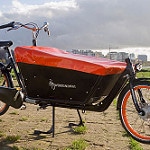The Bicycle in New York, From an Artistic Viewpoint
TweetMay 9, 2007
By COLIN MOYNIHAN
To look at nearly any bicycle — from graceful racers with inch-thick tires to the clunky, rusted workhorses of food delivery fleets — is to behold a union of form and function that has existed for nearly two centuries. Bicycles, after all, have been transporting people at least since 1817, when Baron Karl von Drais invented a contraption in Germany that operated without pedals and required riders to push against the ground with their feet to propel themselves.
Look closely though, and there are aspects that transcend the utilitarian. People who ride regularly tend toward the philosophical when they describe why. Some view bicycles as political symbols with which to make a statement about carbon emissions from cars. Others are inspired by the mobility that bikes can provide in a crowded urban setting. Then there are those who are invigorated by the physicality of pedaling or simply savor the way the city looks when viewed from atop two wheels.
Last week, an exhibition called “Why I Ride: The Art of Bicycling in New York,” which examines the experience of riding, opened at four locations in Lower Manhattan.
“We wanted the show to be a comprehensive representation of many riding segments,” said Carol Wood, a financial writer from Chelsea, who was one of two organizers of the exhibition. “We wanted the exhibit to show there’s not one stereotypical cyclist, there are cycling cultures, plural.”
Ms. Wood, who is a member of an advocacy group called the New York Bicycling Coalition and an art group called Veloprop, said she got the idea last fall for a show that would translate into visual form the feeling of riding a bicycle in New York City.
Along with Elizabeth Stuelke, a member of Veloprop and a magazine editor from the Upper East Side, she began soliciting submissions. The two women selected photographs, drawings, paintings and installations by 15 artists or art groups, as well as 28 essays that appear in the show’s catalog.
Some of the work is displayed at the Lower East Side Girls Club, on East First Street. Works are also on display at bicycle shops on Second Avenue, Lafayette Street and Eldridge Street. The exhibition lasts through June 3.
The art includes photographs of working bicycle messengers; paintings that emphasize the clean, spare lines of stripped-down bikes designed for speed; and an aquatint, etching and marker image that drew inspiration from the greasy chain imprints that stain the calves of some cyclists.
Several works are political, like an installation called “Resist: The Critical Mass Mugshot Project,” which depicts 40 of the several hundred riders who have been arrested in the last few years while participating in monthly bike rides that take place in Manhattan without a permit. The people in that piece are shown photographed straight ahead and in profile, and the project is intended to provoke questions about law enforcement and the nature of criminality.
“I was looking for depth of feeling,” Ms. Stuelke said of the selection process. “We wanted work that showed experience and passion.”
Essays in the catalog include ruminations about the joy of riding over bridges and the indignity of suffering the theft of a bicycle. There is also a polemic by a City Council member, Rosie Mendez, called “Whose Streets? Our Streets!” in which she argues that bicycling is a vital form of transportation that deserves to be encouraged by legislation.
Although much of the work in the show sought to communicate the pleasures of bicycling, some also addressed the hazards.
The catalog’s opening essay, written by a performer who goes by the name Reverend Billy, was titled “A Prayer to Our Lady of Perpetual Pedaling.” It is a hymn to faith and safety and was dedicated to the memory of Eric Ng, a 22-year-old bicyclist who was killed on a West Side bicycle path last December when he was struck by a car driven by a man who was charged with being drunk.
Hanging on the rear wall of the Girls Club were several oil paintings by Christopher Cardinale that depicted Mr. Ng and other bicyclists who died after being struck by vehicles. Chris Parkman, 39, a graphic designer from Harlem, stood with two friends and examined the portraits.
“This is one of the most challenging cities I can think of to ride in,” Mr. Parkman said. “Seeing something like this really drives the point home.”
Source: New York Times


















May 23rd, 2007 at 03:45
Hello, and thanks for mentioning our exhibit on your lovely site! Need I say that cycling in the US is in a primitive state compared with Europe? Some of us are working hard to change that–maybe it will be better by the time we are in wheelchairs. Still, we invite you to view our exhibit catalogue, which you can download at http://www.whyiridenyc.org. Thanks again!
–Carol and Elizabeth
May 29th, 2007 at 16:27
Hi, I ws born and raised in NY so I’m all too well aware of the massive differences between cycling in Amsterdam and New Amsterdam (and the entire New World for that matter). So we make and export the honest, practical bikes needed to change the situation and watch with amusement as others like yourselves and everybody in the catalog does their part.
What we really need now is a dealer of our Old Amsterdam bikes in New Amsterdam. As usual the west coast is leading the charge here. Anybody have some candidates?
Groeten,
Henry